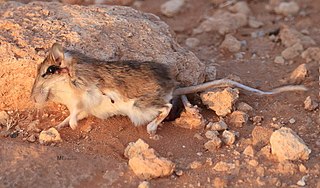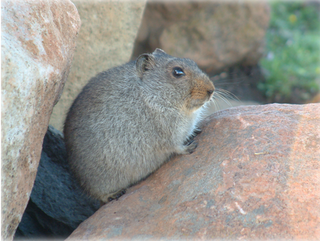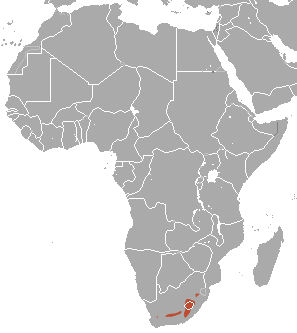Description
The maned rat's body can grow up to 14 inches (360 mm) long, or 21 inches (530 mm) from head to tail. The coat consists of long, silver and black-tipped guard hairs over a dense, woolly, grey and white undercoat, with the face and limbs having short, black fur. A mane of longer, coarser black-and-white banded hairs extends from the top of the animal's head to just beyond the base of the tail. This mane is bordered by a broad, white-bordered strip of hairs covering an area of glandular skin. The forelimbs and hind limbs have short black fur. The forefeet are large and digit 1 of the forefeet does not have a claw while digits 2-5 have a well developed claw. [3]
When the animal is threatened or excited, the mane erects and this strip parts, exposing the glandular area. The hairs in this area are, at the tips, like ordinary hair, but are otherwise spongy, fibrous, and absorbent with a honeycomb structure. [4] The rat is known to deliberately smear these hairs with poison from the bark of the Acokanthera schimperi , the poison arrow tree, on which it chews, thus creating a defense mechanism that can sicken or even kill predators which attempt to bite it. [5] It is the only rodent known to utilize and store toxins [6] from a different species in nature to protect itself, with no known adverse effects to themselves. [7]
L. imhausi differs from typical Muridae in having the temporal fossa roofed over a thin plate of bone, rudimentary clavicles, and an opposable hallux. The dorsal surface of the skull is covered with small bony projections which gives it a pebbled look. The projections are 0.3mm across and are separated every 0.3mm. On these grounds, it has been made the type of a family; its dentition, however, is typical Cricetine. [8] The dental formula is 1/1, 0/0, 0/0, 3/3, giving it a total of 16 teeth. The cusps of the molars are arranged biserially and connected medially by longitudinal enamel crests. [9]
The white-tailed rat also known as the white-tailed mouse, is the only member of the subfamily Mystromyinae in the family Nesomyidae. This species is sometimes placed in the subfamily Cricetinae due to similarities in appearance between the white-tailed rat and hamsters, but molecular phylogenetic studies have confirmed that the two groups are not closely related. The subfamily Mystromyinae is sometimes placed within the family Muridae along with all other subfamilies of muroids.

Tarabul's gerbil is a species of small rodent which is found in arid regions of north western Africa.
The West African shaggy rat is a species of rodent in the family Muridae. It is found in Benin, Cameroon, Ivory Coast, Gambia, Ghana, Guinea, Guinea-Bissau, Liberia, Mali, Nigeria, Senegal, Sierra Leone, and Togo. Its natural habitats are subtropical or tropical seasonally wet or flooded lowland grassland and swamps. It is a common species and the International Union for Conservation of Nature has rated its conservation status as being of "least concern".

The North African gerbil is a species of rodent in the family Muridae. It is found in North Africa where its natural habitats are arable land and rocky areas of the Maghreb, and hot Saharan deserts.
The montane hylomyscus or montane wood mouse is a species of rodent in the family Muridae. A long-coated species with brownish-grey upper parts and whitish-grey underparts, it occurs in the uplands of tropical Central Africa where its natural habitat is tropical moist montane forests.
The Mount Oku rat is a species of rodent in the family Muridae. It is the only species in the genus Lamottemys. It is found only in Cameroon where its natural habitat is subtropical or tropical moist montane forests. It is threatened by habitat destruction.
Lemniscomys linulus, commonly known as the Senegal grass mouse or Senegal one-striped grass mouse, is a species of rodent in the family Muridae. It is found in Ivory Coast, Guinea, Mali, and Senegal and its natural habitat is dry savanna. At one time considered to be a subspecies of Lemniscomys griselda, it is now accepted as a species in its own right.
The Ethiopian forest brush-furred rat or golden-footed brush-furred rat, is a species of rodent in the family Muridae. It is endemic to Ethiopia where its natural habitat is subtropical or tropical moist montane forests. It is threatened by habitat loss.

Sloggett's vlei rat or ice rat is a species of rodent in the family Muridae. It is found in southern Lesotho and South Africa where its natural habitats are subtropical or tropical high-altitude grassland, swamps, and rocky areas. Its name commemorates Col. Arthur Sloggett who served in South Africa and collected at Deelfontein in 1902. This is a common species and the International Union for Conservation of Nature has rated it as being of "least concern".

Brants's whistling rat or Brants' whistling rat is one of two species of murid rodent in the genus Parotomys. It is found in Botswana, Namibia, and South Africa where its natural habitats are subtropical or tropical dry shrubland and pastureland. It was first described in 1834 by the Scottish zoologist Andrew Smith who named it in honour of the Dutch zoologist and author Anton Brants.
Boehm's gerbil is a species of rodent found in Angola, Burundi, Democratic Republic of the Congo, Kenya, Malawi, Mozambique, Rwanda, Tanzania, Uganda, and Zambia. Its natural habitats are dry savanna, moist savanna, and arable land. This is a common species with a wide distribution which faces no obvious threats, so in 2004 the International Union for Conservation of Nature rated its conservation status as being of "least concern".
The Guinean gerbil is a species of rodent found in Burkina Faso, Gambia, Ghana, Guinea, Guinea-Bissau, Ivory Coast, Mali, Senegal, Sierra Leone, and possibly Liberia. Its natural habitats are subtropical or tropical dry forests, dry savanna, rocky areas and arable land, but it is mostly found in areas laterite or clay soils, and with variable amounts of vegetation and dense scrub. This species is described as common and has a stable population and a wide distribution, so the International Union for Conservation of Nature has rated its conservation status as being of "least concern".

The black-tailed tree rat, also called black-tailed acacia rat or black-tailed thallomys,, is a species of rodent in the family Muridae. It is found in Angola, Botswana, Namibia and South Africa, where its natural habitat is subtropical or tropical dry shrubland. It is both nocturnal and arboreal and makes bulky nests in the trees, often acacias, where it feeds on leaves and buds.

Sclater's golden mole is a species of mammal in the family Chrysochloridae. It is found in Lesotho and South Africa. Its natural habitats are subtropical or tropical dry and high-altitude shrubland, Mediterranean-type shrubby vegetation, temperate grassland, arable land, pastureland, rural gardens, and urban areas. This species is locally common, and the International Union for Conservation of Nature has assessed its conservation status as being of "least concern".
Kellen's dormouse is a species of rodent in the family Gliridae. It is native to tropical Africa where its range extends from the Gambia and Senegal to Kenya and Tanzania. Its natural habitats are subtropical or tropical dry forests, and moist or dry savannah.

The red bush squirrel or red-bellied coast squirrel is a species of rodent in the family Sciuridae, which is found in bush and forest along the eastern seaboard of Africa. It is closely related to P. lucifer, P. vexillarius and P. (p.) vincenti.

The long-tailed forest shrew, or long-tailed mouse shrew, is a species of mammal in the family Soricidae. It is endemic to South Africa, where its natural habitats are Mediterranean-type shrubby vegetation and swamps.
Mammals of Africa is a book series of six volumes from Bloomsbury Publishing. Published in 2013 and edited by Jonathan Kingdon, David Happold, Thomas Butynski, Michael Hoffmann, Meredith Happold and Jan Kalina, it describes every species of African land mammal which comprise 1,160 species and 16 orders.

The squirrel galagos are a group of four species of strepsirrhine primates. They are classified in the genus Sciurocheirus of the family Galagidae.










